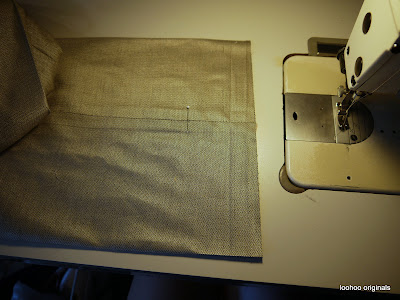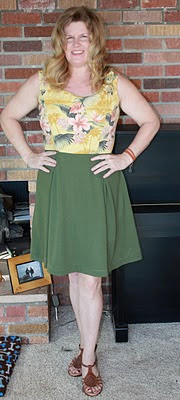I bought some great
pants from Ann Taylor recently, a rayon/cotton/spandex blend herringbone fully lined in poly, with cuffed hems. For $40, thank you additional 40% off clearance rack. When taking them apart to re-hem, I really liked the way they did it, so here for your future assistance (or total confusion, we'll see) is the method. This creates a 1 3/4" cuff, I'm sure you could modify the numbers to make it wider or narrower but I'll leave the math to you.
(If you're starting with already hemmed pants, you need to rip out all the previous stitching. Yes it's a pain, just get it over with and then pretend it didn't happen.)
1. You need a 3" hem allowance. That means 3 inches of fabric below where you want the pants to stop. Easiest way to figure this out is measure the inseam (inside leg seam from crotch to hem) on a pair of pants that is the length you want. If you don't have any to measure, fold up a hem and secure with pins, then try on. Repeat until you find the right length and then measure the inseam. Once you've marked the length, measure 3" past that and cut off the excess fabric.
 |
| Pin is marking finished length, there is 3" of fabric past that. See those previous fold lines? I like my pants to be a little longer in back, so I altered the slope of the cut, which is why it isn't parallel to the old hem lines. |
2. Finish the raw edge. For this method you need 1/2" tape, preferably something soft like hem lace, rayon seam binding, etc. All I had on hand in a lighter color was twill tape, which was a little too stiff for my taste but it got the job done. Working from the right side of the pants, sew the tape to the edge leaving 1/2 the tape hanging over. I sewed one pass right on the edge of the tape, then another down the middle. This fabric was fraying like mad and the second pass helped hold it. Doesn't really matter where you start sewing, and you don't need to precut the tape. When you get back to where you started, cut it long enough to tuck the end under, then sew it down over the raw edge.
 |
| Tape attached to edge, with end folded over the raw edge and sewed down. |
3.
Fold up 4" to the outside and press. Don't ask why yet. Just do. The 4" includes the tape, you should have ~1/4" of tape hanging off the edge of the fabric. The pants are right side out, and you flip the fabric out so the right sides are touching.
 |
| Pants are right side out, hem is flipped up. Fold up 4" and press. |
 |
| PRESS. PRESS I SAY! |
4. Sew a 1/4 inch seam. Pants are still right side out, and you are sewing on the wrong side. This is the cool part. This seam will help hold the cuff in place later.
 |
| Sew 1/4" seam along pressed edge. |
5. Fold the top of the cuff. Turn the pants inside out. A ham or sleeve roll will make it easier to press this, you'll need to do it in sections. Fold the seam you just sewed towards the bottom of the pants, and leave 2 1/2" inches of fabric + tape hanging off the bottom. Press into place. You will not be pressing open that seam you sewed, there should be a ~ 1/2" fabric 'bump' to the left of it. Do this all the way around the hem.
 |
| Pants inside out, fold seam towards bottom and leave 2 1/2" of fabric/tape. |
 |
| PRESS |
6. Fold the bottom of the cuff. Turn the pants right side out, and press again. See that fabric bump now? Fold the tape to the inside of the pants, creating a 1 3/4" cuff on the outside. Press, repeat. We're almost done.
 |
| Pants are right side out, fold tape hem to inside of pants. |
 |
| Make a 1 3/4" cuff by folding the tape hem to the inside. |
 |
| PRESS AGAIN. Are you tired of this yet? |
7. Sew the hem tape to the inside of the pants. I totally cheated here, I used steam-a-seam. But the nice thing about this method is you've got a little pad of fabric to sew (or glue) to, which won't be seen from the front because it's covered by the cuff. You can hand sew this (easily, since you don't have to hide the stitches), use steam a seam or stitch witchery, or if you've got a blindstitch machine, have at it.
 |
| Sew hem tape to inside of pants. There should be a nice fold of fabric to sew to that won't show on the cuff. |
 |
| Cheater's best friend. |
 |
| I worked in 3-4" sections, sticking down the tape and then ironing to fuse it. |
 |
| Finished hem on the inside. The tape is bunching up a bit, when I did the second side I pulled it taut while sewing to ease in the fabric. Turned out much better, but I did not retake the photos so you get to look at my wonky tape. Even so it still looks good from the outside, so I'd say this method is pretty forgiving. However if you want it to look super purty from the inside, use a softer tape and tug on the tape slightly while sewing it to the raw edge. |
 |
| And the outside! |
8. Stitch in the ditch along the two side seams. You can do this on a regular machine, the stitches will be hidden in the 'ditch' of the seam. This will help hold the cuff in place. In case you happen to be walking down a hallway at work and catch your high heel in the cuff and go flying towards the floor. Not that I've experienced that or anything. But at least your hem won't come undone.
That's it! I'd say the second leg only took me about 15 minutes to do, so it's not a huge amount of time for a professional looking hem. Also, most of the other methods I've seen use a longer hem allowance (4"), so this one saves an inch of fabric. Good ready-to-wear is chock full of great methods to learn.



















Comments
Post a Comment